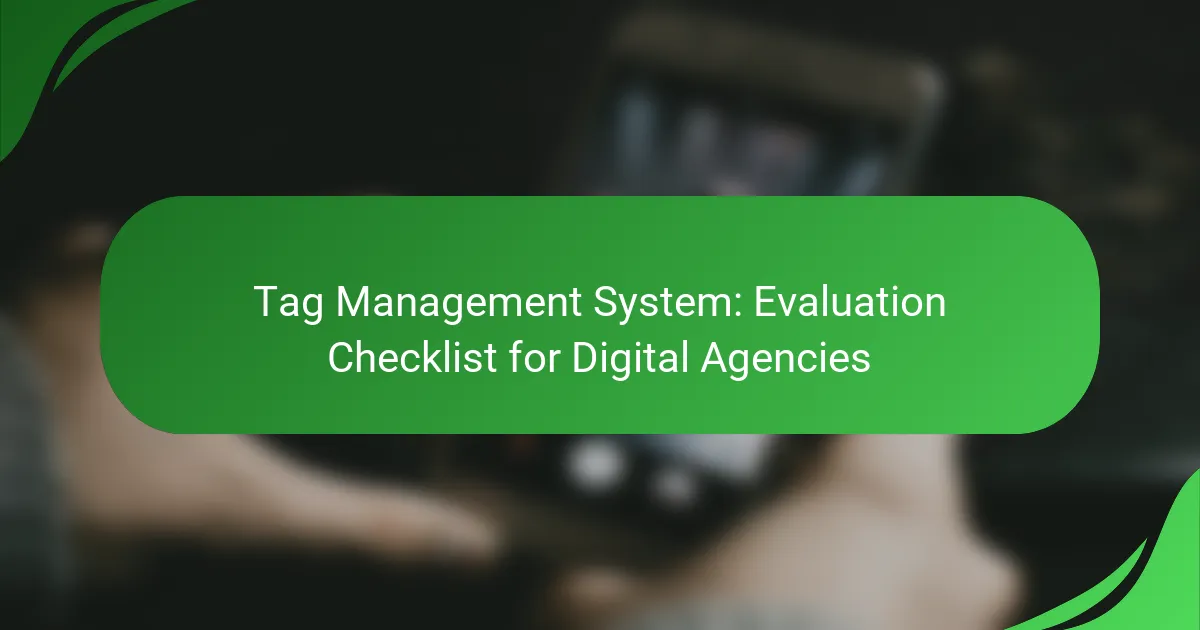Evaluating a Tag Management System (TMS) is crucial for digital agencies looking to optimize their marketing and analytics efforts. A robust TMS should offer centralized control, seamless integration with existing tools, and user-friendly features that facilitate efficient tag deployment. By focusing on key functionalities such as version control and real-time updates, agencies can enhance their tracking capabilities and overall performance.

What are the key features of a Tag Management System for digital agencies in Canada?
A Tag Management System (TMS) for digital agencies in Canada should provide essential features that streamline the management of marketing and analytics tags. Key functionalities include centralized control, version control, integration capabilities, a user-friendly interface, and real-time updates to ensure efficient tag deployment and management.
Centralized control
Centralized control allows agencies to manage all tags from a single interface, reducing the complexity of handling multiple scripts across various platforms. This feature simplifies the process of adding, editing, or removing tags without needing extensive coding knowledge.
With centralized control, agencies can ensure consistency in tag deployment, which is crucial for accurate data collection and reporting. It also minimizes the risk of errors that can occur when managing tags across different systems.
Version control
Version control is vital for tracking changes made to tags over time, allowing agencies to revert to previous versions if necessary. This feature helps maintain the integrity of data collection and ensures that any updates do not disrupt ongoing campaigns.
Agencies should look for a TMS that offers easy access to version history and the ability to compare changes. This can prevent potential issues that arise from untested modifications and provide a safety net for tag management.
Integration capabilities
Integration capabilities are essential for connecting the TMS with various marketing and analytics tools. A robust TMS should support seamless integration with platforms like Google Analytics, Facebook Pixel, and other third-party services.
When evaluating a TMS, agencies should consider the number of integrations available and the ease of setting them up. A system that supports a wide range of integrations can enhance data accuracy and streamline marketing efforts.
User-friendly interface
A user-friendly interface is crucial for ensuring that team members can easily navigate the TMS without extensive training. Look for systems that offer intuitive dashboards and drag-and-drop functionality for tag management.
An accessible interface can significantly reduce the time spent on tag implementation and troubleshooting, allowing agencies to focus more on strategy and less on technical details.
Real-time updates
Real-time updates enable agencies to deploy tags instantly, ensuring that tracking is always current. This feature is particularly important during high-traffic events or campaigns where timely data collection is critical.
Agencies should prioritize a TMS that allows for immediate changes and provides instant feedback on tag performance. This responsiveness can enhance the effectiveness of marketing strategies and improve overall campaign outcomes.

How to evaluate Tag Management Systems for display advertising?
To evaluate Tag Management Systems (TMS) for display advertising, focus on their ability to streamline tag deployment, enhance tracking capabilities, and integrate with existing marketing tools. Key considerations include cost, scalability, support, and performance tracking features.
Cost-effectiveness
Cost-effectiveness is crucial when selecting a Tag Management System. Look for systems that offer transparent pricing models, whether subscription-based or pay-as-you-go. Compare the total cost of ownership, including setup, maintenance, and potential hidden fees, to ensure it fits within your budget.
Consider the return on investment (ROI) a TMS can provide by improving campaign efficiency and reducing reliance on development resources. A system that saves time and enhances data accuracy can justify a higher initial cost.
Scalability
Scalability refers to a TMS’s ability to grow with your business needs. A good TMS should handle an increasing number of tags and data sources without performance degradation. Evaluate how easily the system can accommodate new features or integrations as your advertising strategy evolves.
Check if the TMS supports multiple environments, such as staging and production, and whether it can manage tags across various platforms. This flexibility is essential for agencies managing diverse client portfolios.
Support and training
Effective support and training are vital for maximizing a TMS’s potential. Assess the level of customer support offered, including availability of live chat, email, or phone assistance. A responsive support team can help troubleshoot issues quickly, minimizing downtime.
Training resources, such as documentation, webinars, and tutorials, can significantly impact user adoption and proficiency. Look for systems that provide comprehensive onboarding and ongoing education to ensure your team can leverage all features effectively.
Performance tracking
Performance tracking capabilities are essential for measuring the effectiveness of your display advertising campaigns. A robust TMS should offer real-time analytics and reporting features that allow you to monitor tag performance and user interactions seamlessly.
Consider whether the TMS integrates with analytics platforms to provide a unified view of campaign performance. This integration can help you make data-driven decisions and optimize your advertising strategies based on actionable insights.

What are the top Tag Management Systems for digital agencies in Canada?
The leading Tag Management Systems (TMS) for digital agencies in Canada include Google Tag Manager, Adobe Experience Platform Launch, Tealium iQ, and Segment. These platforms help agencies efficiently manage and deploy marketing tags without extensive coding, enhancing website performance and analytics capabilities.
Google Tag Manager
Google Tag Manager (GTM) is a widely used TMS that allows users to manage JavaScript and HTML tags used for tracking and analytics. It offers a user-friendly interface, enabling agencies to deploy tags quickly without needing to modify the website’s code directly.
GTM supports a variety of tags, including those for Google Analytics, AdWords, and third-party services. Its built-in debugging tools and version control help ensure that tags are implemented correctly, reducing the risk of errors.
Adobe Experience Platform Launch
Adobe Experience Platform Launch is a robust TMS designed for enterprises that require advanced features and integrations. It provides a flexible architecture that allows agencies to manage tags across multiple Adobe products and third-party solutions seamlessly.
This platform emphasizes data governance and compliance, making it suitable for agencies handling sensitive information. However, its complexity may require a steeper learning curve compared to simpler systems like GTM.
Tealium iQ
Tealium iQ is a comprehensive TMS that focuses on real-time data management and audience segmentation. It integrates with various marketing and analytics tools, allowing agencies to create a unified view of customer interactions.
One of its key features is the ability to manage consent preferences, which is crucial for compliance with regulations like Canada’s Anti-Spam Legislation (CASL). This makes Tealium a strong choice for agencies prioritizing data privacy and user consent.
Segment
Segment is a customer data platform that also functions as a TMS, enabling agencies to collect, unify, and route customer data to various tools. Its focus on data integration makes it ideal for agencies looking to streamline their analytics and marketing efforts.
With Segment, agencies can easily implement tracking across multiple platforms without repetitive coding. However, its pricing model may be a consideration for smaller agencies, as costs can increase with data volume and integrations.

What criteria should agencies consider when selecting a Tag Management System?
Agencies should evaluate a Tag Management System (TMS) based on how well it aligns with their business goals, complies with relevant regulations, and offers customization options. These criteria ensure that the TMS effectively supports marketing strategies while maintaining compliance and flexibility.
Business goals alignment
When selecting a TMS, agencies must ensure it aligns with their specific business objectives, such as improving website performance or enhancing data collection. A well-aligned TMS can streamline marketing efforts, enabling better tracking of user interactions and conversion rates.
Consider how the TMS integrates with existing tools and platforms. For instance, if an agency prioritizes e-commerce, the TMS should support e-commerce tracking features to optimize sales funnels and customer insights.
Compliance with regulations
Compliance with data protection regulations, such as GDPR in Europe or CCPA in California, is critical when choosing a TMS. Agencies must ensure that the system facilitates consent management and data privacy practices to avoid legal penalties.
Look for features that help manage user consent and data collection transparently. A TMS that offers built-in compliance tools can save time and reduce risks associated with regulatory breaches.
Customization options
Customization is essential for agencies that require specific tracking setups or unique data layers. A flexible TMS allows for tailored configurations that meet diverse client needs and marketing strategies.
Evaluate the ease of creating custom tags and triggers. A TMS that supports a wide range of customization options can adapt to changing business requirements without extensive technical resources.

What are the common challenges faced when implementing a Tag Management System?
Implementing a Tag Management System (TMS) often presents several challenges that can hinder its effectiveness. Common issues include integration complexities, data governance concerns, and user training requirements.
Integration with existing systems
Integrating a Tag Management System with existing platforms can be complicated. Agencies must ensure compatibility with various analytics tools, content management systems, and marketing platforms. This often requires thorough testing and adjustments to workflows.
To ease integration, consider mapping out all current systems and identifying potential conflicts or gaps. Utilizing a phased approach can help in managing these complexities effectively.
Data governance and compliance
Data governance is a critical challenge when implementing a TMS, especially with regulations like GDPR or CCPA. Agencies must ensure that the data collected through tags complies with legal standards and that user privacy is maintained.
Establish clear policies for data collection and sharing. Regular audits can help ensure compliance and identify any potential risks associated with data handling.
User training and adoption
User training is essential for successful TMS implementation. Without proper training, team members may struggle to utilize the system effectively, leading to underperformance.
Provide comprehensive training sessions and ongoing support to facilitate user adoption. Consider creating user manuals or quick reference guides to assist team members in navigating the TMS efficiently.



